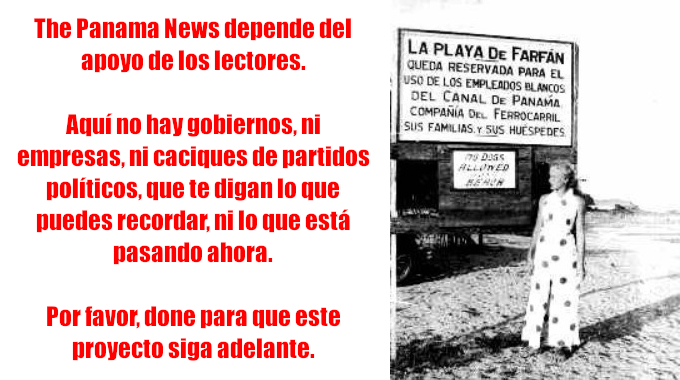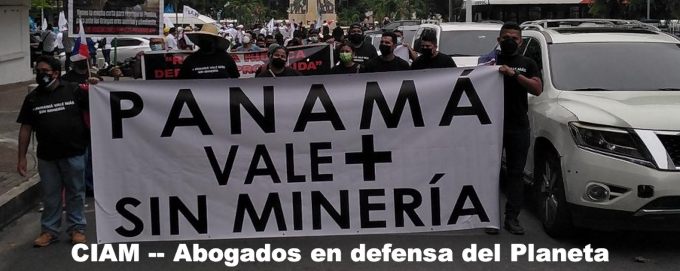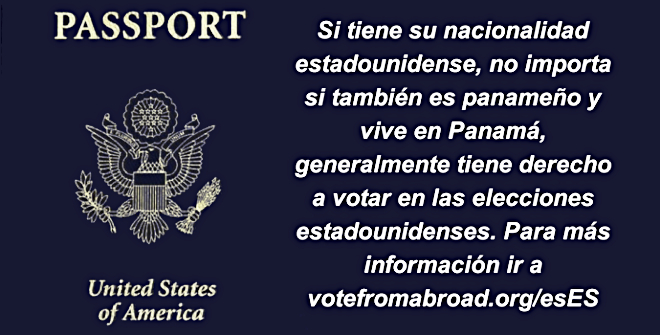From Arraijan to La Chorrera, you can’t travel the Pan-American Highway without noticing the Metro monorail construction. Notwithstanding many questions – for starters why a monorail instead of extending the existing Metro system’s light rail lines – this project is happening. Photo by Eric Jackson, taken from a bus.
Mega-projects – which are or may not be happening, who might gain and which should be put out of their misery
by Eric Jackson
Why was former president Ricardo Martinelli sentenced to prison? Why did the former presiding magistrate of the Supreme Court, Alejandro Moncada Luna, get sent to prison? They may allege criminal defamation because the convictions were formally for subsequent or consequential financial crimes, but the underlying offenses were graft, as in arranging for overpriced construction contracts going to selected organizations and taking a skim out of these overcharges.
So, with Martinelistas back in power and Moncada Luna showing up at Mulino events, shouldn’t we be suspicious? Moreover, with a notoriously corrupt PRD crowd mostly leaving office, and looking past them to all the governments since the 1989 US invasion, should WHO is now in be much more suspect than WHAT is proposed or underway? And then THIS reporter first learned about urban policy mostly on the job, in elected and appointed posts in a small city near Detroit, reading widely and looking around.
“I seen my opportunities and I took ‘em” is an attitude not invented by the guy who said that. Wherever and whenever, those who think and act that way are characters of whom people should be wary.
With such caveats and others in mind, and looking at the lay of the land and the needs and wishes of various Panamanian social sectors, let’s look at some of the major construction projects underway or proposed.
A big part of the Metro Line 3 plan is for park and ride facilities, and another part is bus and train interchanges. Map by the Metro de Panamá.
Line 3 of the Metro, the monorail
Starting at Albrook, passing through a tunnel more than 150 feet below the canal and out to the population centers of Arraijan and La Chorrera, this project is underway and is unlikely to be shut down now. It would be a huge political disaster if it was. Not only because it would be an in-everybody’s-face failure, but because in part it would be squandering a gift from Japan, which subsidizes much of the planning and construction management.
Perhaps the biggest advantage would be beyond the line’s reaches, with people driving into the city from the Interior being able to park their cars, get on the monorail and be in the city in short order. That would relieve congestion on the bridges across the canal and in the capital itself. There would be some of that effect in the other direction too, with parking in Albrook and Balboa to get on the monorail and across the canal into Panama Oeste. Get past the madness and hop on a bus at La Espiga in Chorrera, to be on your way to Coronado, El Valle or beyond? It would also be an attraction for many going the other direction.
We can argue about why a monorail instead of an extension of the other Metro lines’ light rail, but regardless of that and other questions, this project promises to change many urban realities for the better.
The Corredor del Caribe, now stalled pending further litigation before the Supreme Court. Photo by Adopta Bosque Panamá.
The Corredor del Caribe
A 28.4 kilometer road through secondary forests between Quebrada Ancha and just west of Maria Chiquita on Colon’s Costa Arriba, this project is a good illustration of the fallacy of “residential tourism.” As in real estate speculators claiming the mantle of tourism promoters. As in an $87 million project intended to benefit one developer in particular, but which would open the way for much more deforestation along the route, which would be a shortcut from the Panama – Colon Autopista and Transistmica over the ridge to the road along the coast to Portobelo and a bit beyond. Zip right along. They got the former minister of public works, Rafael Sabonge to go along – what could possibly go wrong?
Via TVN. Portobelo Chamber of Tourism president Cristóbal Valencia gave us assurances. The road would not go through designated national parks, or primary forests. That the area being destroyed is rich in wildlife is no big problem, Valencia said. There are ways to move the birds and animals that call the area home to somewhere else.
The Panama Canal Authority is less convinced. This project deforests part of the Chagres River Watershed, potentially affecting rainfall and reducing available water for canal operations. Environmentalists are aghast. We get this optimistic prediction about the road itself, but not the developmental sprawl and deforestation that would follow.
Whatever the court rules, this is a PRD pet, so politics may stop it regardless of the law. A few folks might be incensed about losing that most central of human rights, return on investment. This thing can die without anyone else missing it.
Panamanian law, unlike the Anglo-American Common Law systems, does not get so much into history. But here, if the argument of the projects promoters and defenders about only secondary forests being affected gets enshrined as a principle in our environmental laws, just about everywhere in this country is vulnerable. There is very little primary forest in Panama. The Spaniards conquered a heavily farmed land, one where swidden agriculture was the norm. Cut away a patch of forest, burn what’s cut, then with the ash as fertilizer grow crops for a few seasons before abandoning it for the jungle to grow back and start over on another patch. The Europeans brought not only guns and horses to subdue the locals, but far more effectively if unintentionally they brought in diseases unknown to the pre-Columbian peoples of the isthmus. There was plenty of brutality in the conquest, but the most deadly things were the plagues. So as indigenous farms were abandoned and the forests grew back and became habitats for wildlife again, does the natural growth of the past five hundred years not count? Are only forests cut down in more recent times “secondary” and thus apt to be cut down again? Do we really want court decisions based on the denial of Panama’s human and natural history?
Then there is the consideration of “environment” as more than the bird and bees and flowers and trees. The Colon coastal road to which the Corredor del Caribe would connect. That in short order became an attraction for Colombian drug launches. Only later was policing enhanced. So, do we want a rapid shortcut to Panama’s urban areas from that dope road? And of course it’s not just drugs, but guns and ill-gotten cash, and fugitive criminals and illegal migration.
This project should be an easy throwaway.
Mulino’s first cabinet meeting declared this one a priority.
The Panama – David train
At its first cabinet meeting, the Mulino government announce the creation of a Natonal Secretariat for the Panama – David Train. It’s a project that has been talked about for years, a proposal that was extensively sketched out during the Varela years and then flatly rejected by the Cortizo administration.
For Mulino the train is the centerpiece of a major effort to meet the “notorious emergency” of a crumbling and inadequate land transportation system. This project is going to happen.
Will it meet future needs in light of rising seas? Is it the best route for national development? Will a Chinese company get the job, annoying the United States? These are all real questions, but not insurmountable barriers.
The biggest problem with this project is the context. It’s undertaken without benefit of any overall national development plan. Will it be just a passenger service, or also a means to quickly move perishable agricultural products from farms to the city? Will it swing upwards to connect places like the Ngabe-Bugle Comarca to the rest of the country? Where will it go in Panama City? Will it be more or less an express service, or one with many stops?
The government will muddle through these things, we will get a train and also a bill for it. Then we’ll be able to better judge whether it was a good investment.
This one is underway, and has been. It’s a traffic nightmare in Chorrera. The idea is to run from from an interchange with the Pan-American Highway to a road along the beaches out to Chame or so. Photo from Vivi Montagne’s Twitter / X feed.
Corredor de Las Playas
Here again we have a project that seems mostly for the benefit of real estate speculators, this time a species who want to sell “beachfront properties.” But much of that “beachfront” is environmentally sensitive mangrove forests.
It’s a throwaway that’s not likely to be thrown away.

Climate change is real, but Panamanian government estimates of our vulnerability to it may not be. Government maps? It seems that when it comes to the Atlantic Side there is a paucity of maps showing the road infrastructure – by and large, from Miguel De La Borda in Colon to Bocas del Toro there hardly is any road along the coast. Access to and exports from the copper mine were designed to be by sea. Yet for many years there has been the suggestion that Panama needs a good road all along the Caribbean Sea from Colon to Bocas. Map by the Tommy Guardia institute.
The road from Colon to Bocas
When the copper mine is definitively kicked out – all of their toxic semi-processed ore, their machinery, their corporate security guards gone – there will remain this port along the coast, and roads that wind across the isthmus to Penonome. There will be the temptation for wildcatters to move in and look for gold on their own. There will be a need for police to guard against that, and against criminal gangs from taking over and using the port for their nefarious ends.
When you think about it, there is mixed news in that. Finish the long-contemplated road and it would attract smugglers, so there would be a need for cops anyway. Convert the port to a little facility serving our central provinces and there would first be a roadbuilding base and ultimately a facility that might serve the farms, businesses, tourism and residential conveniences of such up-over-the hills places as El Valle, Penonome and San Carlos.
But think about the vulnerability of our country, with only one main drag, the Pan-American Highway along the Pacific Side. Despite the policing issues, a parallel road along the Atlantic Side, with connecting roads here and there, would enhance Panama’s national security in the face of many possible calamities. It would spread our economic development around.
However, there is this stereotype about Colon. High crime, low potential, all of that stuff. The clichés are often enough expressed in overtly racist terms.
Panama is deep in a public debt hole and private investors who don’t intend to loot are hard to come by. It’s likely that this road, a worthy idea, is not happening anytime soon. That’s a pity.
The area around the Rio Indio that has been in legal and political limbo for years, but is now back in a position where the Panama Canal Authority can declare eminent domain, build a dam or two and expand the water supply to run the Panama Canal and for other uses. Map from the Gaceta Oficial.
Damming Rio Indio
Richard Fifer is in prison for fraud, his company’s CEO and her son the would-be PRD president are in disrepute, the Canada-based company that bought part of their mine concession to put in the infamous copper mine is probably the single most hated company in Panama and the attempt to wrest dibs on the Rio Indio waters is at an end with a recent Supreme Court decision. There will be one or more new dams to create a reservoir west of Gatun Lake to alleviate chronic Panama Canal water shortages. There is more or less a national consensus to do this.
That would not end all controversies. For years, at just about every opportunity, the Panama Canal Authority (ACP) has hinted that in such an undertaking rabiblanco business mores rather than solidarity among Panamanians would apply. Remove the people in the way of the dam as cheaply as possible, with no concerns about ways of life or established communities. The new lake could be created with those displaced being treated with dignity, respect and generosity. Old farms could be replaced with new farms, even better farms. On the other hand, a bad imitation of stingy billionaire power plays could get Panama’s roads blocked off again.
If done right, the new lake’s water would not all be needed for canal operations and a lot of it could be siphoned off for agricultural and household needs. Would we still hear somebody say that it would be better used to process metal ores? Hardly anybody wants to hear THAT.
The estimate is that it would take six years to build such a project. The political estimate is that in the meantime there would be an attempt to promulgate a new Panamanian constitution, in the drafting of which issues of water rights and the status of the ACP would likely be broached.
Contact us by email at thepanamanews@gmail.com
To fend off hackers, organized trolls and other online vandalism, our website comments feature is switched off. Instead, come to our Facebook page to join in the discussion.
These links are interactive — click on the boxes
>
































